CHEVROLET S10 1997 2.G Owners Manual
Manufacturer: CHEVROLET, Model Year: 1997, Model line: S10, Model: CHEVROLET S10 1997 2.GPages: 402, PDF Size: 21.04 MB
Page 201 of 402

Downloaded from www.Manualslib.com manuals search engine NOTICE:
If you leave your radio on, it could be badly
damaged. The repair wouldn't b-e covered
by
your warranty.
I€ your vehicle has air conditioning, the auxiliary
electric
fan under the. hood can start up even
when- the engine- is not running and can injure
you. Keep hands, clathhg and tools away'from
any underhood
electric fan.
Page 202 of 402
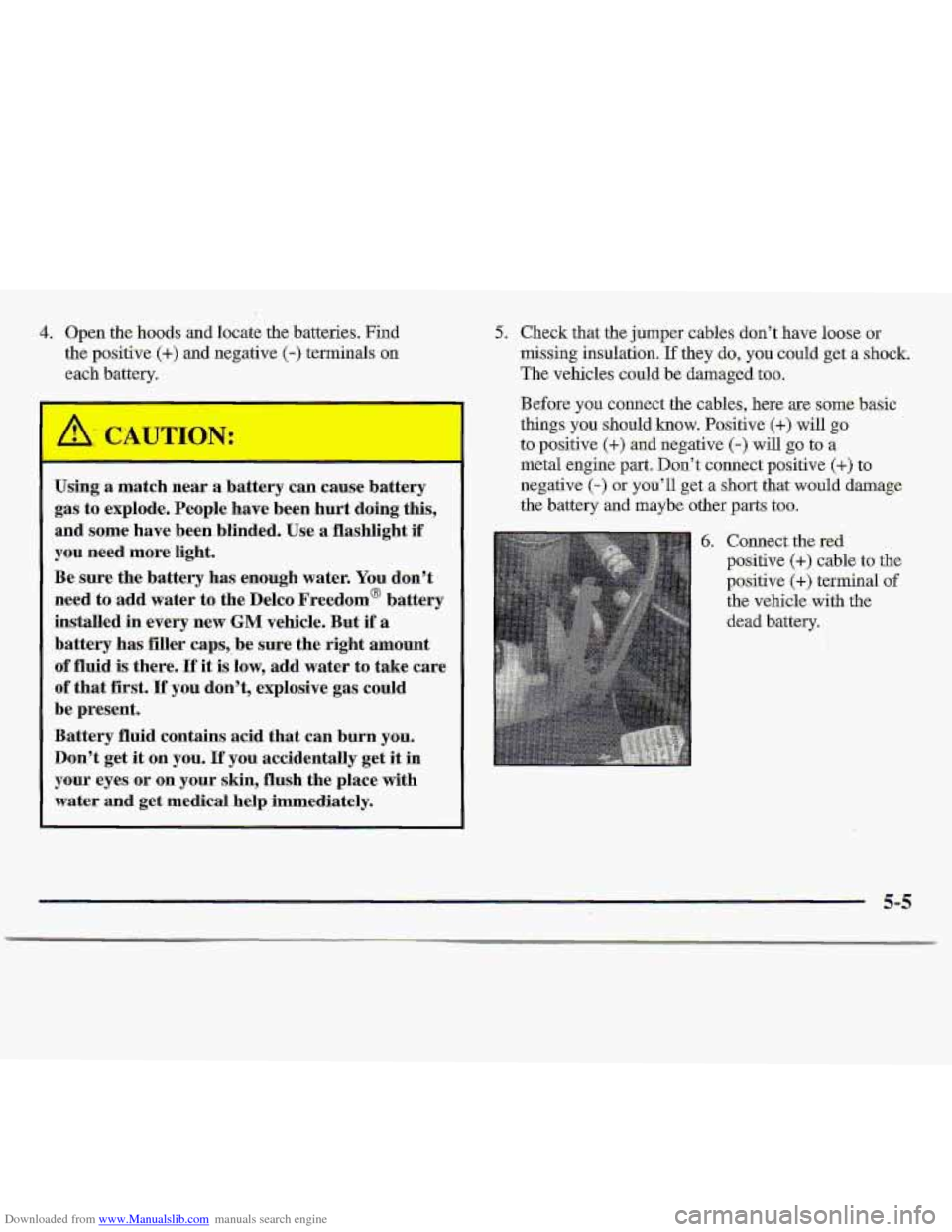
Downloaded from www.Manualslib.com manuals search engine 4. Open the hoods and locate the batteries. Find
the positive
(+) and negative (-) terminals on
each battery.
Using a match near .a battery can cause battery
gas to explode. People have been hurt doing this,
and some have been blinded. Use a flashiight
if
you need more light.
Be sure the battery has enough water.
You don’t
need to add water
to the Delco Freedom@ battery
installed
in every new GM vehicle. But if a
battery has filler caps, be sure the right amount
of fluid is there. .If it is‘low, add water to take care
of that fist, If you don’t, explosive gas could
be present.
Battery
fluid contains acid that can burn you.
Don’t get it on you. If you accidentally get it in
your eyes or on your skin, flush the place with
water and get medical help immediately.
5. Check that the jumper cables don’t have loose or
missing insulation.
If they do, you could. get a shock.
The-vehicles could be damaged too.
Before you connect the cables, here are some- basic
things
you should know. Positive (+> will ga
to positive (+) and negative (-) will go to a
metal engine
part. Don’t connect positive (+) to
negative
(-) or you’ll get a short that would damage
the battery and maybe other parts too.
6. Connect the red
positive
(+) cable to the
positive
(+) terminal of
the vehicle with the
dead btittery.
Page 203 of 402
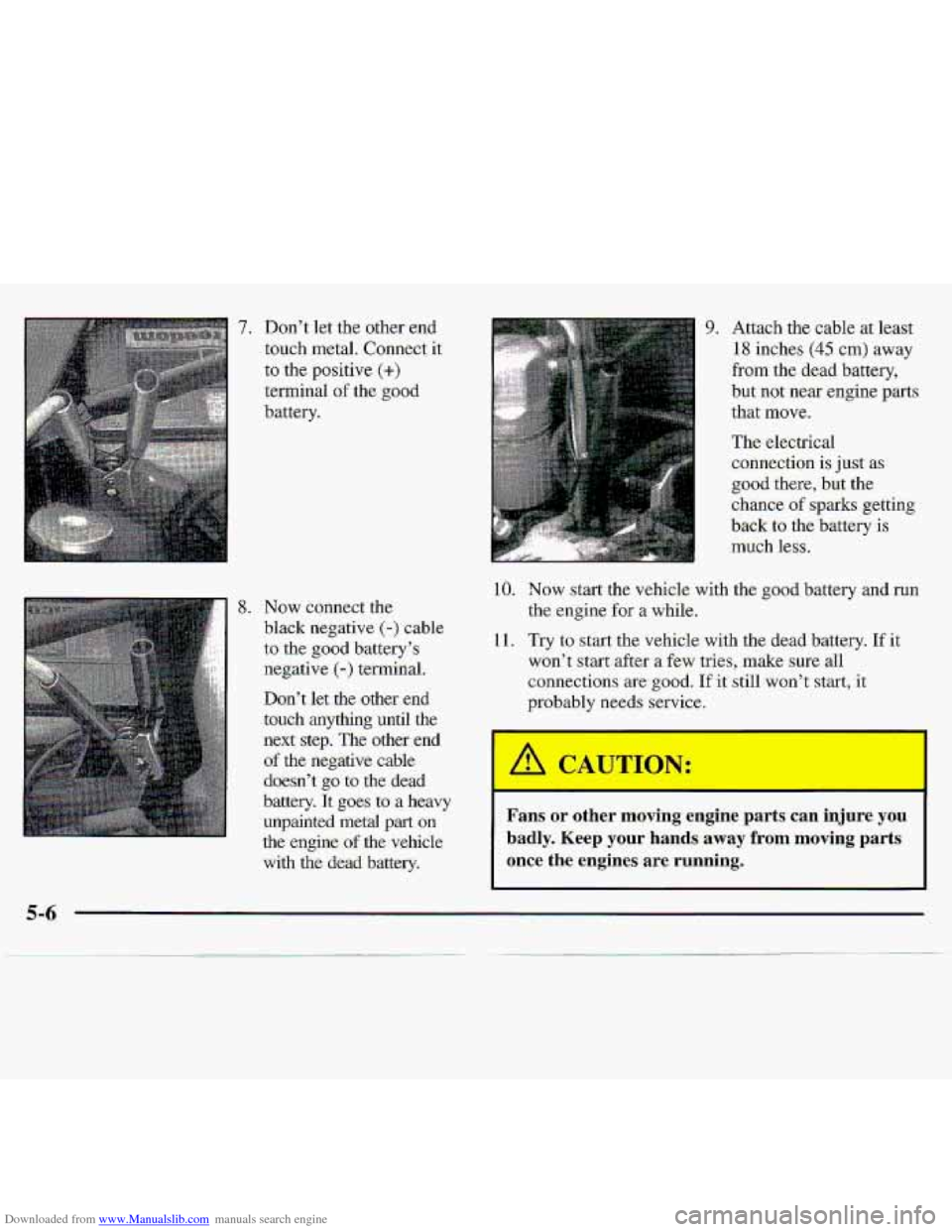
Downloaded from www.Manualslib.com manuals search engine 7. Don’t let the .other.end
touch metal. Connect it-
to the positive
(+)
terminal of the good
battery.
8. Now connect the
black negative
(-1 cable
to the good battery’s
negative
(-> terminal.
Don’t let the other end
touch
anything until the
next step. The other end
of the negative cable
doesn’t
go to the dead
battery.
It goes to.a heavy
unpaiked
ketal part on
the engine .of the vehicle
with the
dead battery.
9. Attach the cable at least
18 inches (45 cm) away
from the dead battery,
but
not near engine parts
that move.
The electrical
connection
is just as
good there, but the
chance
of sparks getting
-back
to the battery is
much less.
10. Now start the vehicle with the good battery and run
the engine for a while.
11. Try to start the vehicle with the dead battery.
If it
won’t start after
a few tries, make sure all
connections are
good. If it still won’t start, it
probably needs service.
Fans or other moving engine parts can injure you
badly. Keep your hands away from moving parts
once the engines .are running.
5-6
Page 204 of 402

Downloaded from www.Manualslib.com manuals search engine 1.2. Remove me cables in reversemder .to prevent
electrical shGrting. Take c.ae that they don’? touch
each .other, or any other metal.
A. Heavy Metal Engine Part
B. Good Battery
C. Dead Battery
Page 205 of 402
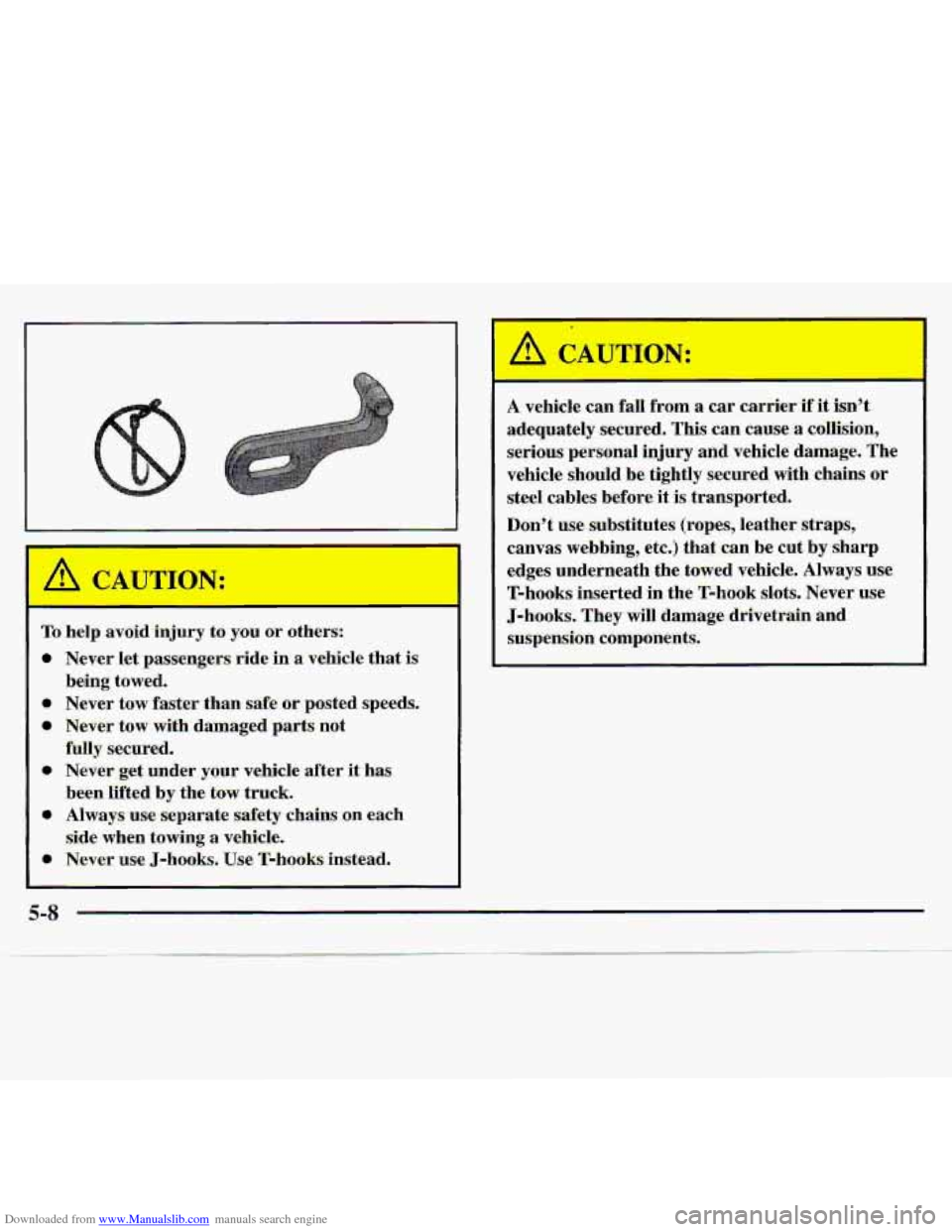
Downloaded from www.Manualslib.com manuals search engine I
TO hdp avoid injury to you or! otfiws:
* Never let passengers ride in a vehicle that is
@ Never tow faster than safe or posted speeds.
0 Never taw "wish d.amage.d piarts not
0 Never.@ under your vehicle after it has
being towed.
fully secured,
been.
I[i€ted by the tow truck.
Always we s,eparate safety chains..on each
.side -when towing a vehicle.
0 Newr use J-hooks. Use T-hooks instead.
A vehicle can fall from a car carrier .i it isn't
adequately secured.
This can cause a .:collision9
serious personal injury and vehicle damage. The
vehicle
shouid.be tightly secured with chains or
steel cables before
it is transported.
Dan% use substitutes (ropes, leather-straps,
canvas webbing, etc.) that can be cut by sharp
edges. underneath thedowed vehicle. Always use
T-hooks inserted in the T=hook slots, Never use
J-hooks. They will damage .drivetrain *and
suspension components.
Page 206 of 402
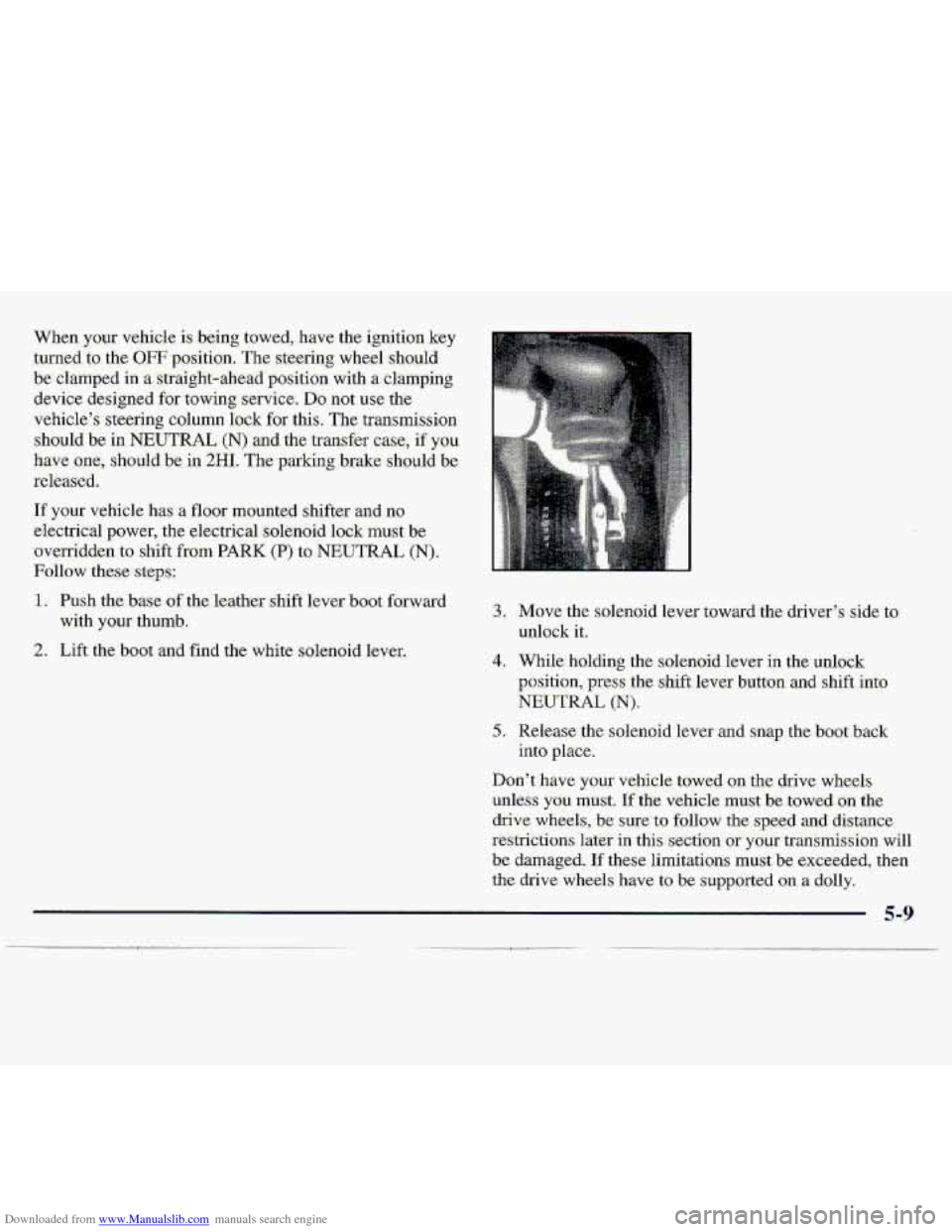
Downloaded from www.Manualslib.com manuals search engine When your vehicle is being towed,. h-ave the ignition key
. md.& ;the OFF- position.. The ite,erin,g wliegl sli~ultl
be. cla-mped in- a straightdahezd position witb a clamping
&vice desi:ped for towing-service. DO fiat ust the
vehicle's steering c.olumxz I-ock for this. The transmission
should be in
NEUTRAL (N) an-d the .transfer case, if you
'31ave one, ShQuLd. be in 2HI. The p&ing.bm.ke shguld-.-lje
seleased.
If your vehicle has. a flqor mounted shifter and no
.electrical power,
the electrical.So1enoi.d lock must be
.ovexKidd.m tu shi%t-.hm PARK (P> :to NEUTRAL (Nj.
Follow -:these. step.8:
1. Push the'bme of the.'€e.ather shift leva boat forward
with
your thumb.
L
3.
4.
5'.
'Move the solenoid. lever toward the driver's side to.
m1oc.k it;
'While holding the solenoid lever in the unlock
gosition, press the shift lever button and shift into
NEUTRAL
(N).
Release the solenoid lever and snap the b.QgL.b.a&
into place.
,... . .
Don't have your vehi-cle towed on th-e drive wheels
unless you must. If -the Vehicle .must be towed--on. the
drive wheels, be sure to follow the. sp.e.ad and distance
restrictions
Mer in this section oryour transmission will
be damaged.. If these limitations must be exceeded, the0
the drive wheels have to b:e supported on .a dolly.
Page 207 of 402
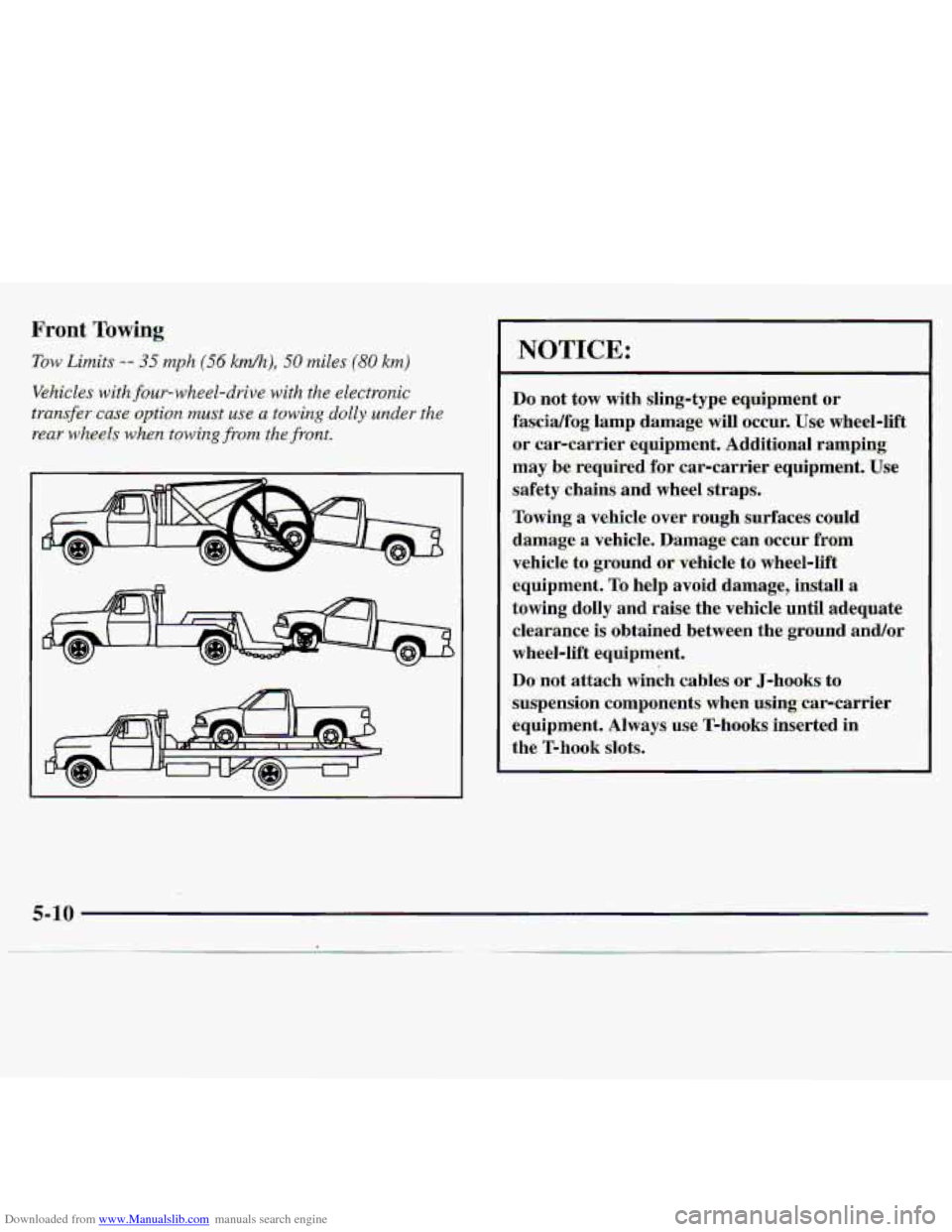
Downloaded from www.Manualslib.com manuals search engine Front Towing;
Tow.Limits. -- 35 rnph (56 kmh), 50 miles (-8O-km)
lrehicles with fuur-whesl-drive with the electronic
-transfercase opth must use a towing dolly under the
mar whe& when towing from the fipnt.
NOTICE:
Do not tow with sling-type equipment or
fascia/fog lamp damage will occur. Use wheel-lift
or car-carrier equipment. Additional ramping
may be. fequiped for car-earrier equipment.
Uk
safety chains and wheel straps.
Towing a vehicle over rough surfaces could
damage
a vehicle. Damage can occur from
vehicle to
ground or vehicle to wheel-lift
equipment.
To help avoid damage, instan a
towing doIly and raise the vehicle until adequate
clearance is obtained between the-ground and/or
wheel-lift equipment.
Do
not attach winch cables or J-haoks to
suspension components. when using;car-carrier
eq-uipment. Always use
T-hooks inserted in
the
T-hook-slots.
Page 208 of 402
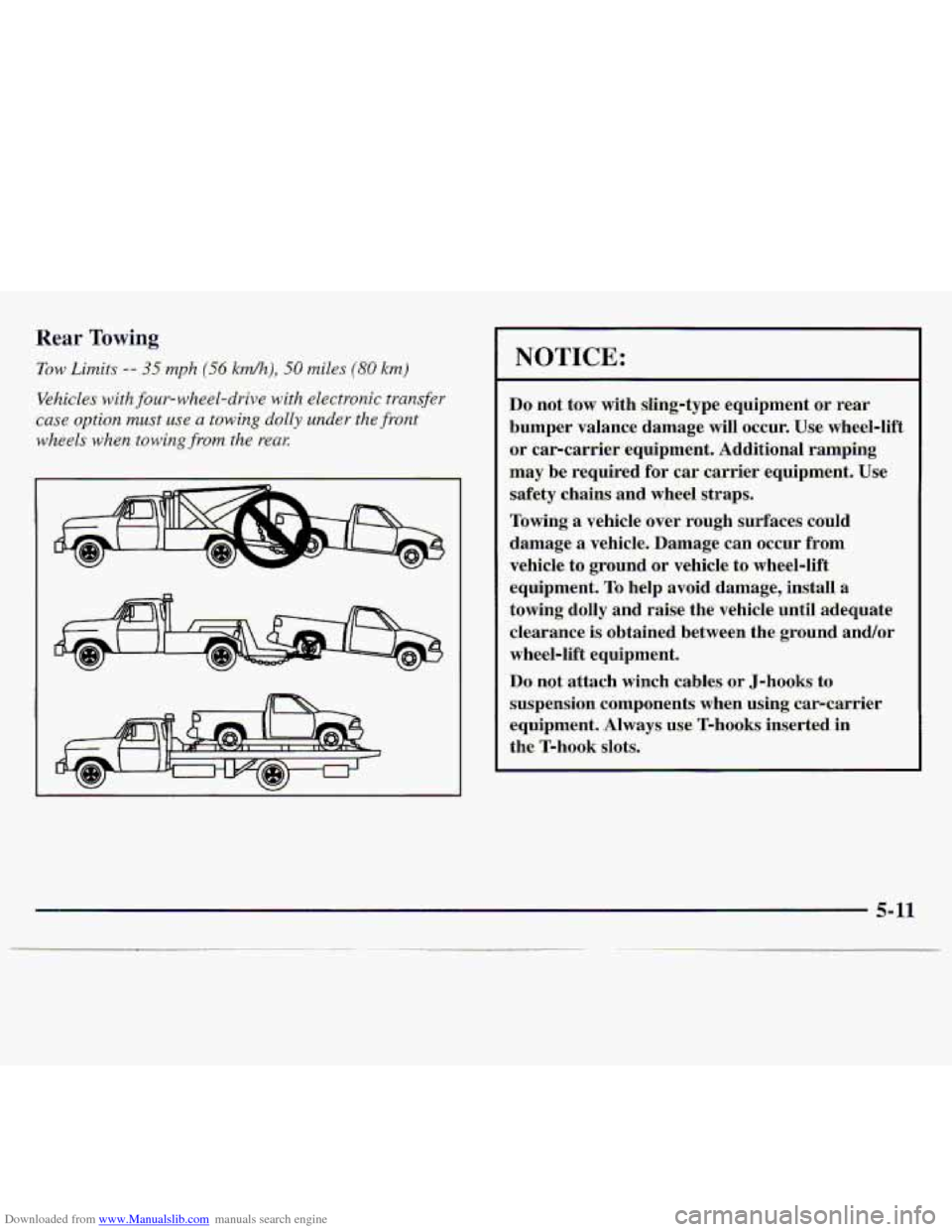
Downloaded from www.Manualslib.com manuals search engine Rear Towing
Tow Limits -- .35 mph (56 kwdh), 50 miles (SO kmj
Vehicles with four-whe&dvive with EkctroHic transfer
case option must use a towing, dolly under th.efron;t
~vheels when towing- frmn the reaz
NOTICE:
Do not tow with sling-type equipment or rear
bumper valance damage will occur. Use wheel-lift ,
or car-carrier equipment. Additional rainping
may
be required for car carrier equipment. Use
safety chains
and wheel straps.
Towing
a vehicle over rough Surfaces could
damage a vehicle. Damage
can occur from
vehicle to .ground
or vehicle to wheel-lift
eq-uipment.
Ta help avoid darnage, install a
towing dally and raise the vehicle until adequate
clearance is obtained between the
ground and/or
wheel-lift equipment.
Do not ,attach winch cables or J-hooks ta
suspension components when using car-carrier
equipment.
Always use- T-hooks inserted in
the
T-hook slots.
5-11
Page 209 of 402
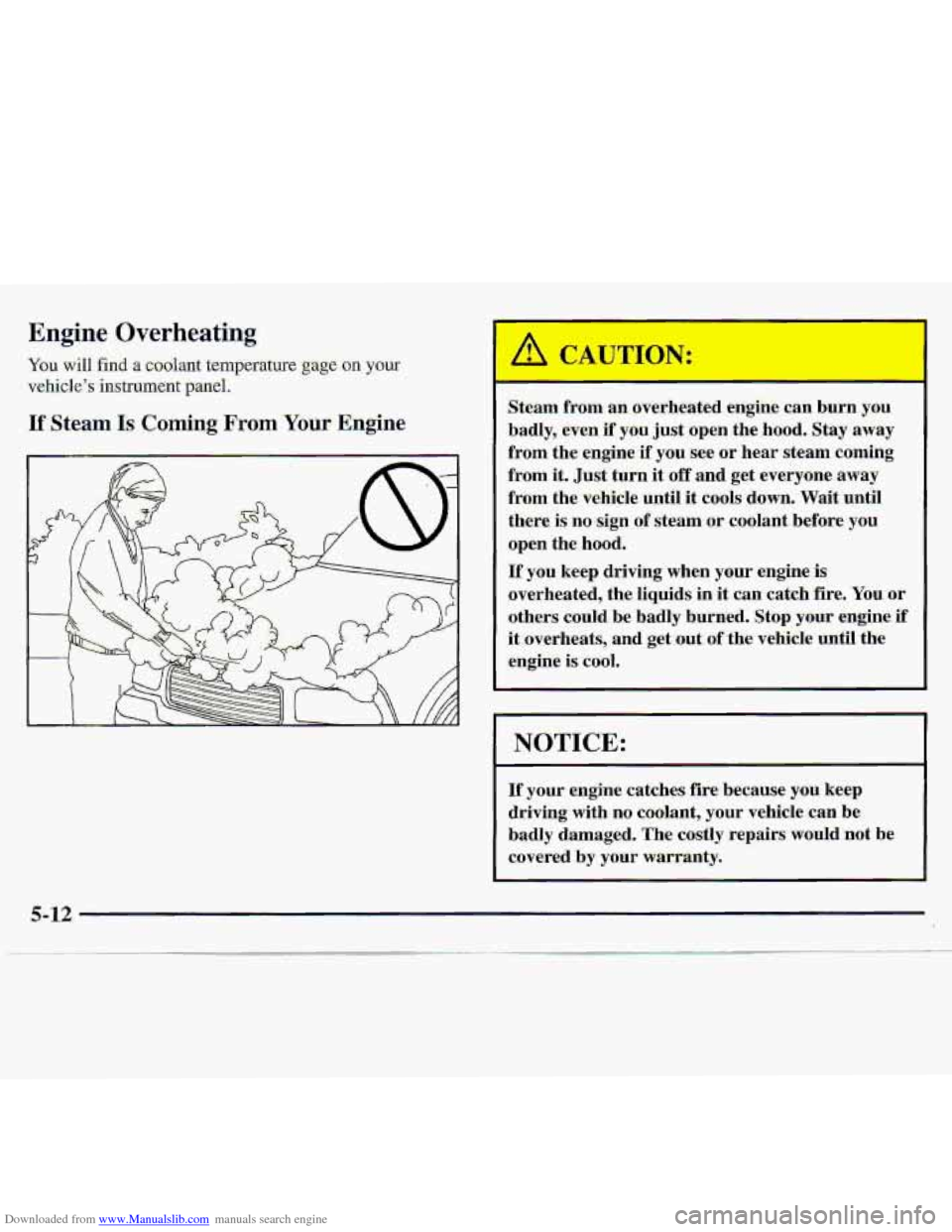
Downloaded from www.Manualslib.com manuals search engine Engine Overheating
YQU will find a coolant temperature gage on your
vehicle’s instrument paneI.
ESteam Is Coming FroniYour Engine
Steam from an overheatdengine can burn y.ou
badly, even if you just open the ho.od. Stay away
from the engine if you see or hear steam toming
from it. Just turn it off and get everyone away
from the vehicle until it cools down. Wait until
there is no sign of-steam or coolant before you
open the hood.
If you keep driving when your engine:is
overheated, the liquids in it can catch.fire. You
.or
others could be badly burned. Stop your engine if
it overheats,, and getmt of the vehicle until. the
engine
is cool.
NOTICE:
I
If your -engine catches fire. because you keep
driving with no co.olant, your vehicle can b.e
badly damaged. The costly repairs would..not. be
c~overed by your warranty.
5-12
Page 210 of 402

Downloaded from www.Manualslib.com manuals search engine IfNo Steam Is Coming -. From Your Engine
If y0.u get the overheat warning but s.ce or hear RO
steam, the problem may not be too serious. Sometimes
the engine
can get a 1i.ttle too hot when yau:
.O Climb a long hill OLI: a hot day.
0 S.top after high-speed driving.
0 Idle for long periods in traffic.
e- Tow a trailer. See “Dfiving on Grades” in .the Index.
If you get .the overheat warning with no sign of s-team;
try this for a minute or so:-
1. If you have an air conditioner, turn it off.
2. Turn on your heater to full hot at the highest.$gm
speed
and open the window as necessary.
3. 1% you’re in a. traffic jam, shift to NEUTRAL (N);
otherwise, shift to the highest gear while
driving -- AUTOMATlC OVERDRIVE (@) or
DRIVE (D) far automatic transmissions.
If you n.0 longer have the overheat warniiqg,. you
can drive. Just to besafe, driv.e slower for .about
10 minu.tes. If the
warning does;n’.t come back. ofl,
you can drive normdly..
If the warning c.aritinues-, pull OV&, stop, and p-~k y.Our-
vehicle right hway.
If there’s still no sign of steam, push the accelerator Uhtil
the
engine speed is about twice as fast-as normal idie
speed. Bring the. engine speed back to- normal idle sped
after two QP three minutes. Now:s.ye if the warning, stops.
But
&en-, if you still have the .warnhg-, twn qfl--fhc
engine and get Gveryona .out af rhe whicle until it
coois Eo wn.